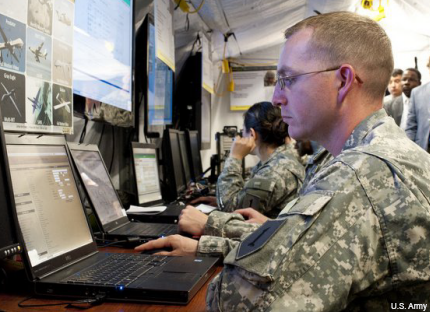Army prepares to take global intel system to the next level
The service is requesting industry input on improving the system’s data gathering, analysis, sharing and compatibility with Intelligence Community standards.

A soldier with the Army intelligence community demonstrates DCGS-A during a 2013 media day.
The Army is getting ready to take the next steps in the development of its evolving global intelligence system, known as the Distributed Common Ground System – Army.
The service has released the second of what it has said will be a series of requests for information for DCGS-A Increment 2, which is expected to expand the system’s capabilities for data gathering, analysis and sharing, and allow it to work with Intelligence Community Information Technology Enterprise being adopted by the 17 intelligence community agencies.
The RFI is seeking feedback on topics ranging from cloud computing and big data analytics to data fusion and sensor management. The solicitation also seeks to address the system’s ease of use, with Army acknowledging soldiers have had some complaints.
The earlier RFI sought information on the latest technologies in data ingestion, analytics and visualization, along with evaluations of DCGS-A software and systems. It also sought input on a potential shift from the government as the prime integrator, as was done with Increment 1, to a prime-contractor model.
DCGS-A is the backbone of the Army’s efforts toward developing situational awareness and actionable intelligence, combining geospatial, sensor and other information in support of troops around the world. The 116th Military Intelligence Brigade, for example, uses DCGS-A to provide aerial intelligence to deployed forces in all contingency areas of operation.
"Our capabilities include full-spectrum geospatial intelligence and signals intelligence supporting deployed forces in overseas contingency operations,” Col. Adam R. Hinsdale, the brigade commander, said in a recent Army post. “Most importantly, we are 100-percent powered by the Distributed Common Ground System-Army, on a converged infrastructure — a first for our Army. In fact, DCGS-A in many cases controls the aerial platform sensor over 8,000 miles away."
With Increment 2, the service wants to improve the system’s ability to work with intelligence, surveillance and reconnaissance (ISR) data from unmanned aerial systems, fuse data, provide cross-domain security and perform automated foreign language translation. The Army also wants to explore using the system with thin clients.
The Army has scheduled an Increment 2 industry day for Jan. 20, 2015. Competition for venders will get going in 2016.




